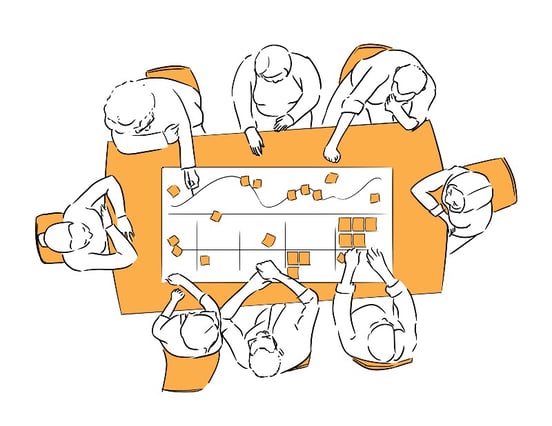
So you see the value of mapping out your customer’s desired end-to-end experience with your service or product — but how do you go about doing it? There are different ways, but the most efficient and effective method is to invite customers into the process as co-creators of the journey. Hands down, there is no more meaningful way to envision future experiences. You need to invite the people who will use and interact with your product or service into the process of designing (not just testing) the interactions and touchpoints.
What’s more, the interactions that come from bringing together customers, your business team and your design team will foster new insights. The collaborative process proves itself extremely valuable — likely more valuable than consumer focus groups or ideation sessions alone. This means the solutions that emerge in these multi-stakeholder sessions or “co-creation” sessions are likely to be more creative, sustainable, and lead to innovative advances, versus getting ideas that only bring incremental changes.
Why does the co-creation approach work so well?
- With the customers right there, you can quickly get down to the rationale and emotional drivers that they have at key decision points in the journey. You learn their needs and have the option to probe for design criteria. And before you’re done, you can test and get their feedback on the whole journey.
- Having consumers in the room will likely challenge some of your assumptions or at least correct some of the biases your internal team may have. The process can save time and money.
- It makes it easier to get decision makers’ buy-in if they know that the future state map involved direct input (dreams and desires) from consumers.
You might already be familiar with the common approach to experience mapping, which amounts to a waterfall style process. There can be a lengthy effort to gather user needs and requirements using surveys, interviews and observations. Then, the researchers write up a long report. From there, a design team member (or someone who has an idea of what an experience map is) may try to coordinate data on a wall poster. In this model, the roles of researchers and designers are clearly segregated, and the customers are not involved in the building of the map. Their voice is included, but only from a distance.
For those who want to co-create with consumers instead, there’s good news and there’s bad news. The good news is that any organization that wants to create great value for their customers can move towards co-creating value with their customers by taking small yet strategic steps!
And now the bad news. As you already suspect, bringing end users or customers into your experience mapping process is easier said than done. It can be messy and complicated. There are hurdles to overcome. For example, your organizational culture might view customers as a passive object of study — a “subject” or “user.” Maybe your team has always been “behind the mirror” watching customers give feedback and is a little apprehensive about directly interfacing with them. In the spirit of full disclosure, if your team is currently using the traditional, waterfall style approach to experience mapping, your organization may not be likely to adopt the co-creation model overnight.
If you’re wanting to make progress towards a co-creation approach to envisioning and mapping new experiences, following these 6 guidelines will put you well on your way:
1. Understand that co-creation is a mindset before it is a method or a tool.
Start by having conversations about the value of co-creation. It’s a good idea to educate all your stakeholders about the difference and the benefits between this and other methods. To keep everyone on the same page, show how and when you are going to invite customers into the process. Establishing the role the customers will play throughout the experience mapping journey will relieve any anxiety your team might feel about trying out a new method. Lastly, make it clear that co-creation methods have been proven effective. Show examples of companies who have taken the lead by shifting from a “customers as passive receivers” mindset to “customers as creative experts of their own experiences” mindset.
2. Make sure to invite the right mix of people to the workshop(s).
For future state mapping, it is helpful to have a design team member involved at each small group because they will be involved in the implementation. Designers are trained to think about the user’s experience. They can help visualize moments and touch points as quick pictures which, in a small space, can often say more than words. When making an invite list for customers or consumers, bring back some of the best customers you’ve had from previous research work. Look for the participants that showed the most interest in the topic and are enthusiastic about the future — you’re likely to get much better results.
3. Prepare and plan tools and materials that will enable co-creation.
The conventional way to make an experience map is with post-its and a wall space. However, there are many other more focused ways to extract people’s ideas, emotions and behaviors, such as using projective/generative methods. You can build customized toolkits to help consumers articulate not only what they want to be doing at each touchpoint but also how they want to feel. A great resource for this is “Convivial Toolbox” by Liz Sanders. Building visual and kinesthetic tools takes preparation but it can bring amazing results within a short amount of time. (For specifics about generative tools that help with envisioning future experiences, we plan to share more in a later post.)
4. Prime your participants — get them ready and set expectations!
Within our design research team we have a saying: “It’s a crime not to prime!” Priming homework is a set of activities we ask participants to complete before they arrive for the session. These activities go beyond a pre-read, a report or summary. Priming exercises are designed to actively prepare the participants to articulate their needs, dreams and desires. If you prime them well, your co-creation session will be much more efficient and you can quickly reach deep insights.
5. Brief your internal business team participants for “rules of engagement”
Take time with the internal business team to share how they should interact in the small group with customers, including how you plan to address confidentiality issues, if there are any. It’s also important to discuss appropriate interactions specific to each person’s role. For example, each table should have a team facilitator who moderates the activities. There will be a number of voices at the table but the things that the customers consider relevant or important should carry the most weight. The business team should follow the facilitator’s lead in asking the consumers appropriate questions. Remember: these consumers are coming in to work with you and envision a future experience for a specific topic, so don’t get off track. For example, this may not be the best time for business teams to bring up questions from other projects — things they have always wanted to ask consumers.
6. When in doubt, pilot test it out!
If jumping in and facilitating a co-creation session seems daunting, start small and try it out with just your team and a few consumers. Use this experience as a pilot test before you bring in all the different internal stakeholders. A big part of running a successful co-creation session is the willingness to plan your workshop then give it a try and be open to getting honest feedback. Take notes on how you can better customize the workshop activities to fit your internal culture and the project at hand. If you document the outcomes and invite decision makers into the process it will pay off later- helping you get buy-in and ownership for future projects.
Following these guidelines will help ease the transition from the waterfall style approach that you might be familiar with to the co-creation method of experience mapping with your customers. By including customers in the design (not just testing) process, you’ll be one step closer to innovative solutions with long term business value.
Have you used a co-creation approach to experience mapping? We’d love to hear any thoughts you’d like to add. If you haven’t used it go ahead and try the approach. Keep us posted on how it went. We’d love to hear more about it. Feel free to drop us a line at monica@thestratosgroup.com or @TheStratosGroup on Twitter.


